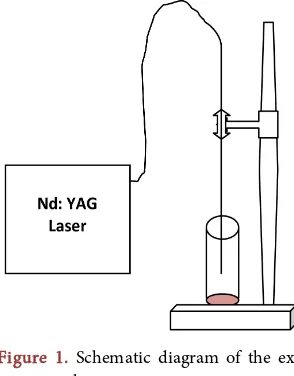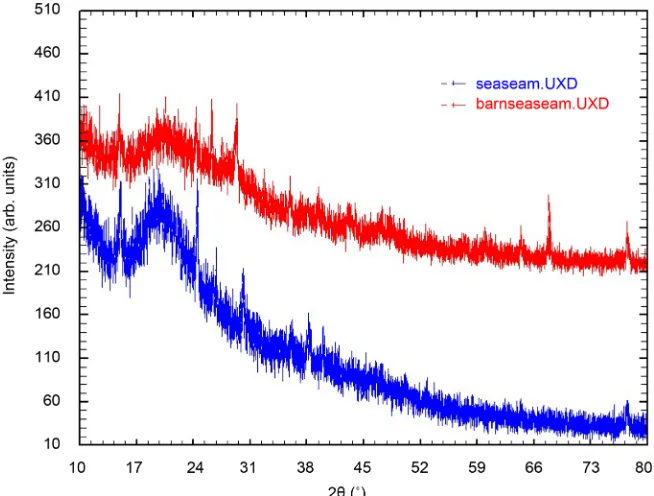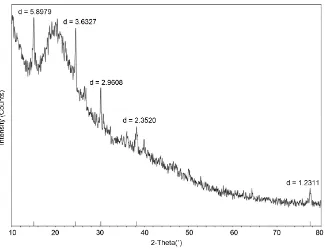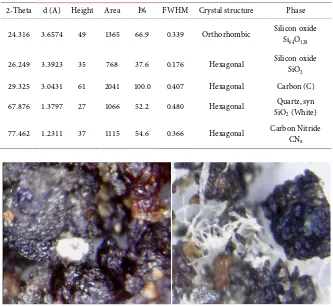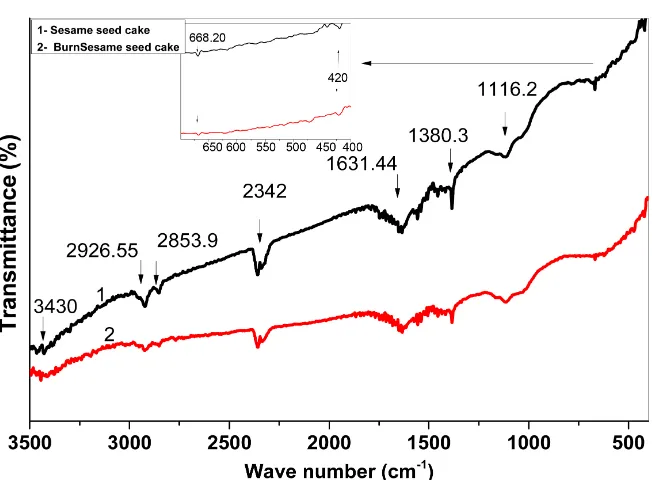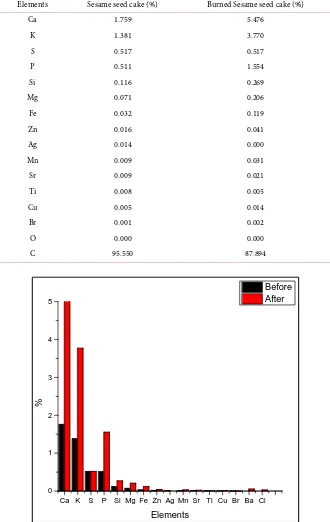ISSN Online: 2327-6053 ISSN Print: 2327-6045
DOI: 10.4236/msce.2018.64013 Apr. 27, 2018 121 Journal of Materials Science and Chemical Engineering
Characterization of the Crystal Structure of
Sesame Seed Cake Burned by Nd: YAG Laser
Muna A. Pn Gawbah
1,2, Abdelrahman A. Elbadawi
2,3, Yousef A. Alsabah
2,4*, Mohammed U. Orsod
5,
Ali A. S. Marouf
61Physics Department, Faculty of Education-Seyoun, Hadhramout University, Hadhramout, Yemen 2Department of Physics, Faculty of Science and Technology, Al Neelain University, Khartoum, Sudan 3Faculty of Basic Studies, Future University, Khartoum, Sudan
4Department of Physics, Faculty of Education and Applied Science, Hajjah University, Hajjah, Yemen 5College of Science, Sudan University of Science and Technology, Khartoum, Sudan
6Institute of Laser, Sudan University of Science and Technology, Khartoum, Sudan
Abstract
This paper reports obtaining of useful and high-value materials from sesame seed cake (SSC). For this purpose, SSC sample was burned for 30 s using Nd: YAG laser with output power 60 W. The products of this process and non-burned SSC were characterized by X-ray diffractometer (XRD), energy dispersive x-ray (EDX) and Fourier transform infrared (FTIR) so as to inves-tigate its crystal structure and chemical components. XRD results of the SSC before burning process showed amorphous silica, rhombohedral phase of carbon, monoclinic phase of aluminum chloride, the hexagonal phase of moissanite-4H, (yellow, black) and hexagonal phase of graphite-2H, C (black). While the results of the burned SSC sample showed that the burning process using the power of Nd: YAG laser cased in appearing of crystalline hexagonal phase for silica and Carbon Nitride and converting the rhombohedral phase of Carbon into hexagonal phase. FTIR showed a number of absorbance peaks assigned to silica.
Keywords
Crystal Structure, FTIR, Hexagonal Carbon, Laser-Based Combustion, Sesame Seed Cake, Sesame Oil Cake, Silica, XRD
1. Introduction
There are a large number of agricultural wastes and they have become an in-creasing concern in recent years, as they may cause significant environmental How to cite this paper: Gawbah, M.A.P.,
Elbadawi, A.A., Alsabah, Y.A., Orsod, M.U. and Marouf, A.A.S. (2018) Characterization of the Crystal Structure of Sesame Seed Cake Burned by Nd: YAG Laser. Journal of Materials Science and Chemical Engineer-ing, 6, 121-131.
https://doi.org/10.4236/msce.2018.64013
Received: February 22, 2018 Accepted: April 24, 2018 Published: April 27, 2018
Copyright © 2018 by authors and Scientific Research Publishing Inc. This work is licensed under the Creative Commons Attribution International License (CC BY 4.0).
http://creativecommons.org/licenses/by/4.0/
DOI: 10.4236/msce.2018.64013 122 Journal of Materials Science and Chemical Engineering problems [1]. With appropriate techniques, agricultural wastes can be recycled to produce useful materials, the source of energy, chemical recovery, chemical or dye adsorption and natural fertilizer for crops [2]. Many investigations show that useful and high-value materials can be obtained from a cheap agricultural waste. For example, rice husk contains about 20% of ash which can be recovered as amorphous silica [3]. Many types of research relating to extraction silica from rice husk and rice straw have been reported [4] [5] [6] [7] [8]. Della et al. found the relative amount of silica was increased after burning out the carbonaceous material at different times and temperatures. A 95% silica powder could be pro-duced after heat-treating at 700˚C for 6 h [4]. Singh et al. discussed synthesis and characterization of rice husk based nano-silica and reported the activated rice husk silica transforms into the crystalline product when burnt above 1000˚C [9].
Also, in wheat husk there are two forms of silica after burning process, crys-talline silica and/or amorphous silica [10]. Chen et al. prepared nano-silica from wheat straw through combustion and acid leaching [11], Naqvi et al. extracted amorphous silica from wheat husk by using KMNO4 [12], and Gawbah et al. used Nd: YAG laser to synthesis silica and some valuable materials from wheat bran [13].
Silica is one of the most important components and can be found in many ap-plications such as biotechnology-related materials, medical-related materials [8], raw materials for cement industry [14]. Tailored materials composed of nano-particles have potential for application in numerous technological fields [6].
In this study, we used sesame seed cake (SSC); it is the residue left after oil ex-traction which used as cattle feed [15] [16]. This residue can be recovered and value added [17]. We burned SSC by a 1.064 µm Nd: YAG laser with 60 W out-put power for 30 s. The advantage of Nd: YAG laser comes from its high gain and good thermal properties; it is the most important solid-state laser for scien-tific, medical, industrial, and military applications [18] [19]. The laser heat was used instead of the heat of the furnace in the burning of SSC and this method saved power, time and effort. Lasers have sufficiently high power with low di-vergence to be able to focus down to a desired size and to have enough power density to heat samples at high pressure; Lasers with high power stability and beam pointing stability are essential for producing a heating spot at steady tem-perature and at a constant position [20]. Silica (SiO2) is a basic raw material that is widely used in electronics, ceramic, and polymer material industries. Due to their small-diameter, silica powders have many technological applications, such as thixotropic agents, thermal insulators, composite fillers, etc. [21]. Silica also has been used as a major precursor for a variety of inorganic and organometallic materials which have applications in synthetic chemistry as catalysts, and in thin films or coatings for electronic and optical materials [22] [23]. Carbon nitrides can applied in the field of catalysis, electrocatalysis, optoelectronics, sensors, se-parations and others [24].
DOI: 10.4236/msce.2018.64013 123 Journal of Materials Science and Chemical Engineering decrease the cost of waste disposal and also convert this waste into value-added products. We studied SSC before and after burning process. The physical and chemical characterizations selected in this study included EDX, XRD, FTIR and Digital Microscope. The objective of the work is to obtain useful and valuable materials like silica and silicon nitride from SSC burned using Nd: YAG laser.
2. Material and Method
2.1. Experimental
SSC sample was collected from Omdurman, Sudan. It was washed with distilled water many times to remove adhering soil and other contaminants then dried at room temperature after that it was milled. One gram of the sample was placed into a high-temperature glass beaker (Schott Duran—Germany) and it was burned on the air by the heat of Nd: YAG laser (Dornier Medilas fiber to 5100) with an output power of 60 W for 30 s. The laser beam was delivered by single mode fiber optic with diameter 125 μm, the distance between the sample and the end of the fiber optic was 1 cm. Because of the small spot size of the laser beam, the process of burning was done point by point, the laser was fixed on a holder while the high-temperature glass beaker was rotated every 30 s carefully for ap-proximately 5 mm see Figure 1, this step repeated many times before investiga-tions for accuracy.
2.2. Characterization
[image:3.595.298.445.528.716.2]Samples were examined before and after burning process by XRD (Shimadzu, MAX_X, XRD-7000) using Cu Kα with scanning speed of 1000˚/min and the da-ta were collected for (2θ) range from 10˚ to 80˚ at a step size of 0.0002˚. The samples were prepared by grinding carefully before XRD measurements by agate mortar for homogeneity. The data were analyzed by MDI jade 0.5 match pro-gram. EDX spectrometer (Shimadzu - EDX-8000) was employed to characterize burned and non-burned SSC samples. It was operated at 4 KV to 50 KV with
DOI: 10.4236/msce.2018.64013 124 Journal of Materials Science and Chemical Engineering software quantitative analysis. The chemical groups presented in burned and non-burned SSC samples were identified by the fourier transform infrared spec-trometer. Samples were mixed with dry potassium bromide powder KBr with a ratio of 1:100, by applying sufficient pressure, the mixture was prepared to scan. FTIR spectra of samples were collected in the wavenumber range of (400 - 4000) cm−1 using (FTIR) spectrometer (Satellite FTIR 5000). Microscopic photograph of the burned SSC was done by (Digital Microscope 400X Digital Zoom).
3. Results and Discussion
3.1. XRD Results
[image:4.595.209.536.452.700.2]The X-ray diffraction patterns were shown in Figure 2, it showed amorphous structure (including multi-phases) of the two samples, Figure 3 and Figure 4 showed the analyzed spectra for the SSC samples before and after burning process analyzed by MDI jade 0.5 match program, graphs showed the presence of the amorphous silica in the two samples, at the normal broad peak at 2θ = 21.7 - 21.8 for the samples before and after burning respectively. It also indicates that laser burning process is very effective to form the crystalline structure phas-es of silica. Therefore, some of the silica phasphas-es appeared in the samplphas-es. In non-burned SSC graph; the phases peaks were appeared at 2θ = 15.009 refer to rhombohedral carbon C (Transparent) phase, at 2θ = 24.484 refer aluminum chloride acetate C10H15 Al2ClO10, at 2θ = 30.159 refer to a monoclinic aluminum chloride hydroxide hydrate Al10Cl3(OH )27!13H2O, at 2θ = 38.234 refer to hex-agonal moissanite-4H, synSiC (yellow, black) and at 2θ = 77.457 refer to hex-agonal graphite-2H C(black). Different phases were appeared after burning
DOI: 10.4236/msce.2018.64013 125 Journal of Materials Science and Chemical Engineering Figure 3. X-ray powder diffraction of nature SSC.
Figure 4. X-ray powder diffraction of burned SSC.
[image:5.595.209.534.343.592.2]DOI: 10.4236/msce.2018.64013 126 Journal of Materials Science and Chemical Engineering Table 1. X-ray diffraction parameters of SSC.
2-Theta d(A) Height Area I% FWHM
Crystal
structure Phase
15.009 5.8979 77 2712 100.0 0.428 Rhombohedral C (Transparent) Carbon
24.484 3.6327 84 1983 73.1 0.287 Unknown Aluminum Chloride Acetate C
10H15Al2ClO10
30.159 2.9608 59 1913 70.5 0.394 Monoclinic Aluminum Chloride Hydroxide Hydrate Al10Cl3(OH)27H2O
38.234 2.3520 37 1394 51.4 0.458 Hexagonal Moissanite-4H, syn SiC (Yellow, black)
[image:6.595.206.539.297.604.2]77.467 1.2311 23 781 28.8 0.413 Hexagonal Graphite-2H C (Black)
Table 2. X-ray diffraction parameters of burned SSC.
2-Theta d (A) Height Area I% FWHM Crystal structure Phase
24.316 3.6574 49 1365 66.9 0.339 Orthorhombic Silicon oxide Si
64O128
26.249 3.3923 35 768 37.6 0.176 Hexagonal Silicon oxide SiO
2
29.325 3.0431 61 2041 100.0 0.407 Hexagonal Carbon (C)
67.876 1.3797 27 1066 52.2 0.480 Hexagonal SiOQuartz, syn
2 (White)
77.462 1.2311 37 1115 54.6 0.366 Hexagonal Carbon Nitride CN
x
Figure 5. Microscopic photograph of the burned SSC (400× Digital Zoom).
3.2. FTIR Analysis
[image:6.595.207.540.299.603.2]DOI: 10.4236/msce.2018.64013 127 Journal of Materials Science and Chemical Engineering Figure 6. FTIR transmittance of SSC samples before and after burning process.
Table 3. FTIR Results of samples.
Absorption Peak
Position (cm−1) Function group/modes of vibration reference
3430 OH stretching and vibration [11] [13]
2926.55 the asymmetric and symmetric vibrations of C-H [25]
2853.9 stretching vibration C-H [26]
2342 − ≡ −C N (Nitrites) and − ≡ −C C (Alkynes) compounds [13] [28]
1631.44 the aromatic stretching [11] [13]
1380.3 stretching vibration C-N [26] [28]
1116.2 the Si-O-Si anti-symmetric stretching mode [3] [13]
668.20 - 420 stretching and bending vibrations to siloxane bonds (Si-O-Si) [11] [13] [29]
The peak at 2853.9 cm−1 attributed to stretching vibration C-H [26]. The absor-bance peak around 2342 cm−1 obtained to − ≡ −C N (Nitrites) and − ≡ −C C (Alkynes) compounds [13] [27]. The peak near 1631.44 cm−1 assigned to the aromatic stretching in SSC structure [11] [13] [23]. The peak at 1380.3 cm−1 at-tributed to stretching vibration C-N [26]. The peak around 1116.2 cm−1 was due to the Si-O-Si asymmetric and symmetric stretching modes [3] [13]. The peaks around (668.20 and 420) cm−1 correspond to siloxane bonds (Si-O-Si) stretching and bending vibrations [11] [24] [13].
3.3. EDX Results
[image:7.595.208.539.357.527.2]re-DOI: 10.4236/msce.2018.64013 128 Journal of Materials Science and Chemical Engineering spectively. The X-ray passed through particles of the samples SSC to detect the presence of element especially the concentration of the carbonate, that noticed It was observed that the concentration of elements in the sample increases after burning for the carbon element shown in Figure 7, this is because a quantity of carbon evaporates in the form of carbon dioxide during combustion.
Table 4. EDX result of samples.
Elements Sesame seed cake (%) Burned Sesame seed cake (%)
Ca 1.759 5.476
K 1.381 3.770
S 0.517 0.517
P 0.511 1.554
Si 0.116 0.269
Mg 0.071 0.206
Fe 0.032 0.119
Zn 0.016 0.041
Ag 0.014 0.000
Mn 0.009 0.031
Sr 0.009 0.021
Ti 0.008 0.005
Cu 0.005 0.014
Br 0.001 0.002
O 0.000 0.000
C 95.550 87.894
Figure 7. EDX result comparison between samples.
Ca K S P Si Mg Fe Zn Ag Mn Sr Ti Cu Br Ba Cl 0
1 2 3 4 5
%
Elements
[image:8.595.207.537.182.704.2]DOI: 10.4236/msce.2018.64013 129 Journal of Materials Science and Chemical Engineering
4. Conclusion
Sesame seed cake (SSC) has silica contents which can be utilized to produce var-ious useful materials. The possibility of producing silica and silicon carbide from SSC was achieved in this study by burning it by Nd: YAG laser. XRD results of the SSC before burning process showed amorphous silica, the rhombohedral phase of carbon, monoclinic phase aluminium chloride, the hexagonal phase of moissanite-4H, synSiC (yellow, black) and hexagonal phase of graphite-2H, C (black). The obtained results showed that burning process using Nd: YAG laser cased in appearing of crystalline hexagonal phase for silica and carbon nitride and converting the rhombohedral phase of Carbon into hexagonal phase. FTIR showed a number of absorbance peaks assigned to silica.
Acknowledgements
First of all authors would like to express their heart full appreciation to almighty God. Secondly gratefully acknowledge Institute of Laser, Sudan University of Science and Technology, Khartoum, Sudan for supporting this work. Also, many thanks for Department of Laser at Al Neelain University for their effort in con-ducting FTIR test for our samples including calibration and operation of FTIR instrument.
References
[1] Zhang, Z., Gonzalez, A.M., Davies, E.G. and Liu, Y. (2012) Agricultural Wastes.
Water Environment Research, 84, 1386-1406.
https://doi.org/10.2175/106143012X13407275695193
[2] Eshenaur, W., Collins, E., Goodrich, P.R. and Wulfe, M. (1984) Understanding Agricultural Waste Recycling: Volunteers in Technical Assistance.
[3] Mehta, A. and Ugwekar, R. (2015) Extraction of Silica and Other Related Products from Rice Husk. International Journal of Engineering Research and Applications, 5, 95-98.
[4] Della, V.P., Kühn, I. and Hotza, D. (2002) Rice Husk Ash as an Alternate Source for Active Silica Production. Materials Letters, 57, 818-821.
https://doi.org/10.1016/S0167-577X(02)00879-0
[5] Liou, T.-H. (2004) Preparation and Characterization of Nano-Structured Silica from Rice Husk. Materials Science and Engineering: A, 364, 313-323.
https://doi.org/10.1016/j.msea.2003.08.045
[6] de Sousa, A.M., Visconte, L., Mansur, C. and Furtado, C. (2009) Silica Sol Obtained from Rice Husk Ash.3, 321-326.
[7] Ghorbani, F., Sanati, A.M. and Maleki, M. (2015) Production of Silica Nanoparticles from Rice Husk as Agricultural Waste by Environmental Friendly Technique. En-vironmental Studies of Persian Gulf, 2, 56-65.
[8] Nandiyanto, A., Rahman, T., Fadhlulloh, M., Abdullah, A., Hamidah, I. and Mu-lyanti, B. (eds.) (2016) Synthesis of Silica Particles from Rice Straw Waste Using a Simple Extraction Method. IOP Conference Series: Materials Science and Engi-neering, 128, 12040. https://doi.org/10.1088/1757-899X/128/1/012040
DOI: 10.4236/msce.2018.64013 130 Journal of Materials Science and Chemical Engineering
of Rice Husk Silica, Silica-Carbon Composite and H3PO4 Activated Silica.
Cerâmica, 54, 203-212. https://doi.org/10.1590/S0366-69132008000200011
[10] Naqvi, H., Saeed, A., Umair, A. and Tajwar, S. (2011) Precipitated Silica from Wheat Husk. Journal of Pakistan Institute of Chemical Engineers, 39, 51-54. [11] Chen, H., Wang, F., Zhang, C., Shi, Y., Jin, G., Yuan, S. (2010) Preparation of
Na-no-Silica Materials: The Concept from Wheat Straw. Journal of Non-Crystalline Solids, 356, 2781-2785. https://doi.org/10.1016/j.jnoncrysol.2010.09.051
[12] Naqvi, J., Shah, F. and Mansha, M. (2011) Extraction of Amorphous Silica from Wheat Husk by Using KMnO4. Journal of Faculty of Engineering & Technology, 18, 39-46.
[13] Gawbah, M.A.P., Marouf, A.A., Alsabah, Y.A., Orsod, M.U. and Elbadawi, A.A. (2017) Synthesis of Silica, Silicon Carbide and Carbon from Wheat Bran and Con-verting Its Crystal Structure Using Nd: YAG Laser. International Journal of Ad-vanced in Physical Science, 4, 31-37.
[14] Habeeb, G.A. and Mahmud, H.B. (2010) Study on Properties of Rice Husk Ash and Its Use as Cement Replacement Material. Materials Research, 13, 185-190.
https://doi.org/10.1590/S1516-14392010000200011
[15] Suja, K., Jayalekshmy, A. and Arumughan, C. (2005) Antioxidant Activity of Sesame Cake Extract. Food Chemistry, 91, 213-219.
https://doi.org/10.1016/j.foodchem.2003.09.001
[16] Bigoniya, P., Nishad, R. and Singh, C.S. (2012) Preventive Effect of Sesame Seed Cake on Hyperglycemia and Obesity against High Fructose-Diet Induced Type 2 Diabetes in Rats. Food Chemistry, 133, 1355-1361.
https://doi.org/10.1016/j.foodchem.2012.01.112
[17] Sarkis, J.R., Michel, I., Tessaro, I.C. and Marczak, L.D.F. (2014) Optimization of Phenolics Extraction from Sesame Seed Cake. Separation and Purification Tech-nology, 122, 506-514. https://doi.org/10.1016/j.seppur.2013.11.036
[18] Koechner, W. (2013) Solid-State Laser Engineering. Springer, Berlin.
[19] Koechner, W. and Bass, M. (2006) Solid-State Lasers: A Graduate Text. Springer Science & Business Media, Berlin.
[20] Shen, G., Rivers, M.L., Wang, Y. and Sutton, S.R. (2001) Laser Heated Diamond Cell System at the Advanced Photon Source for in Situ X-Ray Measurements at High Pressure and Temperature. Review of Scientific Instruments, 72, 1273-1282.
https://doi.org/10.1063/1.1343867
[21] Sun, L. and Gong, K. (2001) Silicon-Based Materials from Rice Husks and Their Applications. Industrial & Engineering Chemistry Research, 40, 5861-5877.
https://doi.org/10.1021/ie010284b
[22] Lender, P.W. and Ruiter, R. (1990) Novel Inorganic Materials and Heterogeneous Catalysis. Inorganic and Metal-Containing Polymeric Materials. Plenum Press, New York, 187-195.
[23] Brinker, C.J. and Scherer, G.W. (2013) Sol-Gel Science: The Physics and Chemistry of Sol-Gel Processing. Academic Press, Cambridge.
[24] Kailasam, K., Epping, J.D., Thomas, A., Losse, S. and Junge, H. (2011) Mesoporous Carbon Nitride-Silica Composites by a Combined Sol-Gel/Thermal Condensation Approach and Their Application as Photocatalysts. Energy & Environmental Science, 4, 4668-4674.https://doi.org/10.1039/c1ee02165f
DOI: 10.4236/msce.2018.64013 131 Journal of Materials Science and Chemical Engineering https://doi.org/10.1039/C0JM03253K
[26] Chen, J., Zhao, D., Jin, X., Wang, C., Wang, D. and Ge, H. (2014) Modifying Glass Fibers with Graphene Oxide: Towards High-Performance Polymer Composites.
Composites Science and Technology, 97, 41-45.
https://doi.org/10.1016/j.compscitech.2014.03.023
[27] Sahoo, S., Seydibeyoğlu, M., Mohanty, A. and Misra, M. (2011) Characterization of Industrial Lignins for Their Utilization in Future Value Added Applications. Bio-mass and Bioenergy, 35, 4230-4237.https://doi.org/10.1016/j.biombioe.2011.07.009
[28] Bellamy, L.J. (1975) Amides, Proteins and Polypeptides. The Infra-Red Spectra of Complex Molecules. Springer, Berlin, 231-262.
https://doi.org/10.1007/978-94-011-6017-9_12
[29] Chang, Q., Hao, X. and Duan, L. (2008) Synthesis of Crosslinked Starch-Graft-Polyacrylamide-Co-Sodium Xanthate and Its Performances in Wastewater Treatment. Journal of Hazardous Materials, 159, 548-553.
